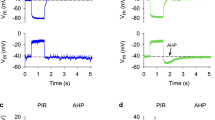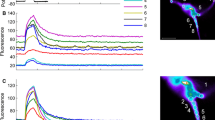Abstract
Small crayfish muscle fibers were voltage clamped and membrane current noise elicited by bath application of quisqualate, a compound structurally related to the excitatory transmitter glutamate, was measured. It was found that quisqualate activates the same excitatory postsynaptic receptors as glutamate but its affinity for these receptors is about one hundred times larger. Noise analysis revealed that the high potency of quisqualate was attributable in part to an increased apparent mean channel open time, τnoise (quisqualate), which was about ten times larger than on activation by glutamate. The channel conductance γ(quisqualate), however, was about three times smaller than γ(glutamate). AtT=8°C andE=−60 mV, τnoise (quisqualate)=9.3±1.8 ms and γ(quisqualate)=9.7±1.1 pS resulted. τnoise (quisqualate) decreased with hyperpolarization but it was much less voltage dependent than τnoise (glutamate): τnoise (quisqualate) =6.0 ms·exp (E/362 mV). Both γ(quisqualate) and α = τ -1noise (quisqualate) increased with temperature (Q10∼1.6). This temperature dependence was characterized by the temperature independent activation energiesE γ=29.1±1.7 kJ/mol andE α=33.9±1.3 kJ/mol. Concanavalin A which blocks desensitization of the quisqualate/glutamate receptors did not influence τnoise (quisqualate) significantly.
Similar content being viewed by others
References
Anderson CR, Stevens CF (1973) Voltage clamp analysis of acetylcholine produced end-plate current fluctuations at frog neuromuscular junction. J Physiol (Lond) 235:655–691
Anderson CR, Cull-Candy SG, Miledi R (1978) Glutamate current noise: post-synaptic channel kinetics investigated under voltage clamp. J Physiol (Lond) 282:219–242
Colquhoun D, Sakmann B (1981) Fluctuations in the microsecond time range of the current through single acetylcholine receptor ion channels. Nature 294:464–466
Colquhoun D, Dionne VE, Steinbach JH, Stevens CF (1975) Conductance of channels opened by acetylcholine-like drugs in muscle end-plate. Nature 253:204–206
Cull-Candy SG, Parker I (1982) Rapid kinetics of single glutamatereceptor channels. Nature 295:410–412
Cull-Candy SG, Parker I (1982) Burst kinetics of single glutamate receptor channels in locust muscle activated by different agonists. J Physiol (Lond) 327:73P
Cull-Candy SG, Miledi R, Parker I (1981) Single glutamate-activated channels recorded from locust muscle fibres with perfused patchclamp electrodes. J Physiol (Lond) 321:195–210
Dudel J (1974) Noninear voltage dependence of excitatory synaptic current in crayfish muscle. Pflügers Arch 352:227–241
Dudel J (1977) Aspartate and other inhibitors of excitatory synaptic transmission in crayfish muscle. Pflügers Arch 369:7–16
Dudel J (1979) The voltage dependence of the decay of the excitatory postsynaptic current and the effect of concanavalin A at the crayfish neuromuscular junction. J Physiol (Paris) 75:601–604
Finger W, Stettmeier H (1980) Efficacy of the two-microelectrode voltage clamp technique in crayfish muscle. Pflügers Arch 387:133–141
Finger W, Stettmeier H (1981) Excitatory synaptic channels in crayfish muscle activated by quisqualate. Pflügers Arch 389 (Suppl):R45/177
Glasstone S, Laidler KJ, Eyring H (1941) The theory of rate processes. Mc Graw Hill, New York, USA
Katz B, Miledi R (1972) The statistical nature of the acetylcholine potential and its molecular components. J Physiol (Lond) 224:665–699
Kawagoe R, Onodera K, Takeuchi A (1981) Release of glutamate from the crayfish neuromuscular junction. J Physiol (Lond) 312:225–236
Kawagoe R, Onodera K, Takeuchi A (1982) On the quantal release of endogenous glutamate from the crayfish neuromuscular junction. J Physiol (Lond) 322:529–539
Mathers DA (1981) The influence of concanavalin A on glutamate induced current fluctuations in locust muscle fibres. J Physiol (Lond) 312:1–8
Mathers DA, Usherwood PNR (1976) Concanavalin A blocks desensitization of glutamate receptors in insect muscle fibres. Nature 259:409–411
Mathers DA, Usherwood PNR (1978) Effects of concanavalin A on junctional and extrajunctionall-glutamate receptors on locust skeletal muscle fibres. Comp Biochem Physiol 59C:151–155
Onodera K, Takeuchi A (1980) Distribution and pharmacological properties of synaptic and extrasynaptic glutamate receptors on crayfish muscle. J Physiol (Lond) 306:233–250
Sakmann B, Patlak J, Neher E (1980) Single acetylcholine-activated channels show burst-kinetics in presence of desensitizing concentrations of agonist. Nature 286:71–73
Shinozaki H (1980) The pharmacology of the excitatory neuromuscular junction in the crayfish. Progres in Neurobiology 14:121–155
Shinozaki H, Shibuya I (1974) A new potent excitant, quisqualic acid: effects on crayfish neuromuscular junction. Neuropharmacology 13:665–672
Shinozaki H, Ishida M (1978b) Prevention of desensitization of the glutamate receptor on the crayfish opener muscle by concanavalin A. J Pharmacol Dyn 1:246–250
Shinozaki H, Ishida M (1979) Pharmacological distinction between the excitatory junctional potential and the glutamate potential revealed by concanavalin A at the crayfish neuromuscular junction. Brain Res 161:493–501
Stettmeier H (1982) Aktivierung erregender postsynaptischer Ionenkanäle des Krebsmuskels durch Glutamat und Quisqualat. Eine Untersuchung mit der Methode der Fluktuationsanalyse. Dissertation, Technische Universität München, FRG
Stettmeier H, Finger W, Dudel J (1978) Synaptic current noise induced by glutamate in crayfish muscle. Pflügers Arch 377:R44/174
Stettmeier H, Finger W, Dudel J (1983a) Glutamate activated postsynaptic channels in crayfish muscle investigated by noise analysis. Pflügers Arch 397:13–19
Stettmeier H, Finger W, Dudel J (1983b) Effects of concanavalin A on glutamate operated postsynaptic channels in crayfish muscle. Pflügers Arch 397:20–24
Takeuchi A, Onodera K, Kawagoe R (1980) Release of endogenous glutamate from the neuromuscular junction of the crayfish. Proc Jpn Acad 56:246–249
Author information
Authors and Affiliations
Additional information
This study was supported by the Deutsche Forschungsgemeinschaft. Project Fi 305/1-1
Rights and permissions
About this article
Cite this article
Stettmeier, H., Finger, W. Excitatory postsynaptic channels operated by quisqualate in crayfish muscle. Pflugers Arch. 397, 237–242 (1983). https://doi.org/10.1007/BF00584364
Received:
Accepted:
Issue Date:
DOI: https://doi.org/10.1007/BF00584364




